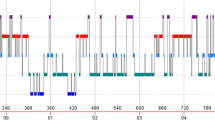Abstract
Characteristic personality profiles of patients suffering from either migraine headache (MH) or tension type headache (TTH) have been described in the light of Minnesota Multiphasic Personality Inventory (MMPI). In the present study we evaluated personality profile changes following modifications of the painful symtoms after treatment, through the administration of the MMPI to MH and TTH patients. In TTH patients with no clinical improvement the depression scale scores were higher after 6 months of treatment, whereas in MH patients similar scores were observed before and after therapy, thus suggesting a primary role of depression in the onset of pain in the latter patients. Computerized EMG recording of the neck muscle activity showed different patterns of muscle contraction in resting condition and during stress or maximal muscular activity in patients suffering from TTH as compared to MH patients and normal subjects.
Somario
Il Minnesota Multiphasic Personality Inventory (MMPI) ha permesso di tracciare profili di personalità caratteristici di pazienti affetti da emicrania (migraine headache, MH) o cefalea di tipo tensivo (tension type headache, TTH). Nel presente studio abbiamo valutato le modificazioni dei profili di personalità da noi ottenuti nei suddetti pazienti in relazione alla presenza o meno di miglioramento clinico valutato dopo sei mesi di terapia. Nei pazienti con TTH in cui la terapia non ha indotto alcun miglioramento clinico, il punteggio ottenuto nella scale della depressione è risultato più alto rispetto a quello ottenuto prima della terapia. Al contrario, in pazienti con MH il punteggio della depressione non si è modificato dopo terapia. Questi dati suggeriscono che la depressione ha un ruolo di primaria importanza nello svilupparsi della sintomatologia algica nei pazienti con MH.
La registrazione elettromiografica dell'attività dei muscoli nucali a riposo non ha messo in evidenza differenze significative tra i due gruppi di pazienti, mentre in condizioni di sforzo muscolare massimo o durante uno stimolo stressante nei pazienti con TTH era evidente una attività muscolare significativamente maggiore rispetto a pazienti con MH.
Similar content being viewed by others
References
Blaszczynsky A.P.:Personality factors in classical migraine and tension headache. Headache 24. 238–244, 1984.
Cohen R.A., Williamson D.A., Monguillot J.E. et al: Psychophysiological response pattern in vascular and muscle contraction headache. J. Behav. Med. 6, 93–107, 1983.
Formisano R., Buzzi M.G., Cerbo R. et al.:Idiopathic headaches: a neuropsychological and computerized electromyographic study. Headache 28, 426–429, 1988.
Formisano R., Cerbo R., Franzese A. et al.:Il test MMPI in pazienti cefalgici. Medicina Psicosomatica 30, 119–135, 1985.
Formisano R., Cerbo R., Martucci N. et al.:Is a migraine patient more sensitive to stressors? A neuropsychological and neurophysiological study. Electromyogr. Clin. Neurophysiol. 28, 405–408, 1988.
Headache Classification Committee of the International Headache Society IHS). Classification and Diagnostic Criteria for Headache Disorders, Cranial Neuralgias and Facial Pan. Cephalalgia 8 (Suppl. 7), 1988.
Henry-Gult R., Rees W.L.:Psychological aspects of migraine. J. Psychosom. Res. 17, 141–153, 1973.
Kudrow L., Sutkus B.J.:MMPI patterns specificity in primary headache disorders. Headache 19, 18–22, 1979.
Lance J.W.:Some clinical aspects of migraine. A perspective survey of 500 patients. Arch. Neurol. 15, 356–360, 1986.
Rees W.L.:Stress, distress and disease. Brit. J. Psych. 128, 3–6, 1976.
Sternbach R.A., D'Alessio D.J., Bowman G.E.:MMPI pattern in common headache disorders. Headache 20, 311–315, 1980.
Van Boxtel A., Goudsward P.:Absolute and proportional EMG levels in chronic headache patients in relation to the state of headache. Headache 24, 259–265, 1984.
Author information
Authors and Affiliations
Rights and permissions
About this article
Cite this article
Formisano, R., Carletto, F., Assenza, S. et al. Tension type headache: a neuropsychological and neurophysiological study. Ital J Neuro Sci 13, 331–336 (1992). https://doi.org/10.1007/BF02223098
Received:
Accepted:
Issue Date:
DOI: https://doi.org/10.1007/BF02223098




